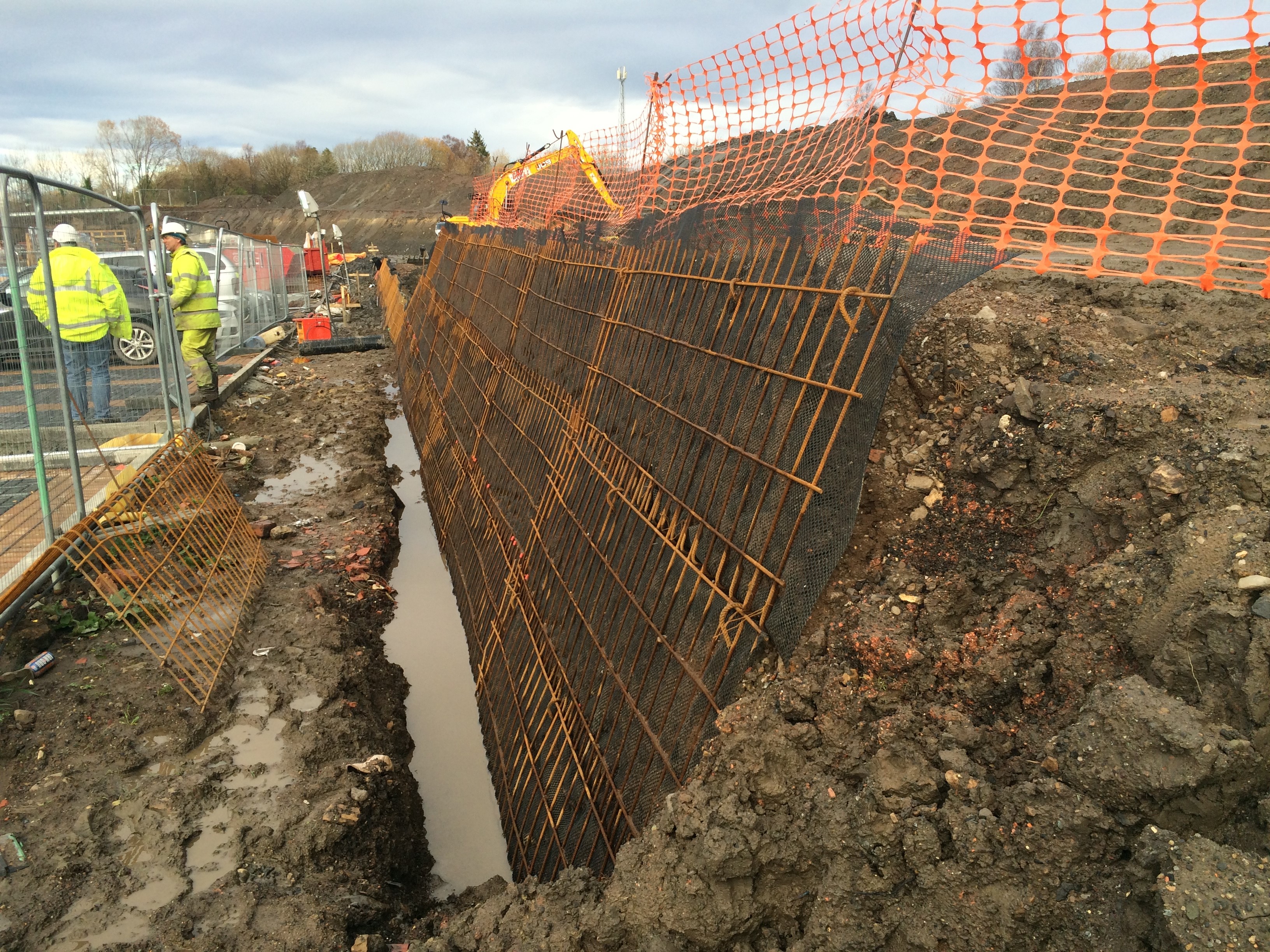Pore water pressure and the importance of drainage
by Andrew Lees, on May 14, 2020
Drainage is a key consideration when designing earthworks, including reinforced soil structures, using compacted clay fill.
Without appropriate drainage, rainfall can saturate the clay and increase its pore water pressure. This, in turn, reduces the effective stress, results in a loss of strength and can potentially lead to failure.
This guide explains the concept of pore water pressure and its role in determining the structural integrity of earthworks. It also outlines how drainage helps to maintain pore water pressure and effective stress, preventing structures from collapsing.
Read on to learn more about:
- What is pore water pressure?
- Effective stress, negative pore pressure and suction
- The importance of drainage in reinforced clay fill
- Designing drainage in geosynthetic-reinforced soil slopes
What is pore water pressure?
Pore water pressure is the pressure of groundwater held between soil or rocks in the gaps (or ‘pores’) between particles. It is affected by the soil type, water flow conditions and level of the water table. Pore pressure is important in geotechnical engineering as it influences soil behaviour, including its shear strength.
Effective stress, negative pore pressure and suction
Ground movement and soil slope instability can be caused by changes in total stress and also by changes in pore pressure, such as after rainfall, when pore pressure can increase.
The difference between total stress and pore pressure is the ‘effective stress’, which controls soil behaviour, such as shear strength, compression and deformation. Effective stress is therefore a measure of how much load a soil can carry.
Below the water table, pore pressure is positive; in dry soils and at the level of the water table, pore pressure is zero; above the water table, soil can remain saturated due to capillary rise but with negative pore pressure (suction). Higher still, the soil becomes partially saturated and suction continues to increase since water molecules are attracted to soil particles and generate surface tension between them. This draws the particles together, giving the soil strength.
A good example of this is wet sand in a sandcastle. The sand will remain damp in the short term due to suction, which increases effective stress and holds the sand grains together. However, over time, as the sand dries, suction is lost and the sandcastle will collapse. It will also collapse if more water is added, as pore pressure will increase and effective stress will reduce, causing a loss of strength.
Ground Coffee – Episode 17. Andrew is in the sand pit this week, explaining the importance of negative pore pressure in sandcastles.
The importance of drainage in reinforced clay fill
It is very important to consider negative pore pressure when designing earthworks, including reinforced soil structures, particularly when using well-compacted clay fill.
Clay fill compacted to a normal earthworks specification is likely to have negative pore pressure up to considerable heights. Pore pressures are only likely to become positive at the base of very high structures (more than 10m to 15m high), or at lower heights, if the clay was wet and therefore soft during placement.
Suction is typically ignored in design and so provides an additional margin against failure or poor performance of the structure. As a result, it is a good idea to maintain suction in the long term.
This means incorporating drainage to prevent the clay fill coming into prolonged contact with free water, which would otherwise saturate it. If the clay fill were to become saturated with water, its pore water pressure would increase, reducing the effective stress and resulting in a loss of strength (potentially leading to failure).
Internal slope drainage must let water drain out and must not let water in. It should be designed to intercept groundwater flow and be free-draining, allowing water to drain out easily and staying ‘dry’ most of the time. It should also not ‘daylight’ at the upper surface of the structure, preventing run-off from flowing into the fill (run-off should be handled by surface water drains, to avoid ponding).
Any movement of a soil structure has the potential to disrupt, or even reverse, the fall of a drain, which could result in water flowing back in – something worth considering when specifying maintenance regimes.
Designing drainage in geosynthetic-reinforced soil slopes
Geosynthetics are used in reinforced soil slopes using clay fill and, in some cases, reinforcement layers incorporate a geotextile drainage fabric, designed to reduce excess pore water pressure.

Eastwood health centre - Clay slope being built
However, while this may be useful in very wet fill, in the more common situation where clay is compacted to normal earthworks specification, any regularly spaced fine drainage layers could actually allow water to penetrate well into the fill. This could increase pore pressure, causing swelling and softening, so is best avoided.
It is far better to incorporate internal drainage behind geogrid reinforcement. This will intercept groundwater flow and, when combined with adequate surface water drains to collect run-off, can reduce the risk of slope failure.

Diagram -Reinforced earth ground water flow
Tensar TensarTech wall and slope systems
With 30 years of construction knowledge, design experience and innovative geogrid products, Tensar’s TensarTech permanent and temporary retaining wall and slope systems provide a number of facing types and construction options to suit the structure’s end use, location and required design life.
Our retaining wall solutions include precast concrete, dry-laid modular block systems (with the option of adding architectural, masonry or brick finishes); precast concrete panel systems; gabion and crib walls; and robust units suitable for aggressive marine environments. Our reinforced soil slope solutions can create vegetated slopes with angles of up to 70˚.
Want to learn more about retaining walls?
Learn more in our Introduction to Retaining walls



-(1).png?width=400&height=400&ext=.png)